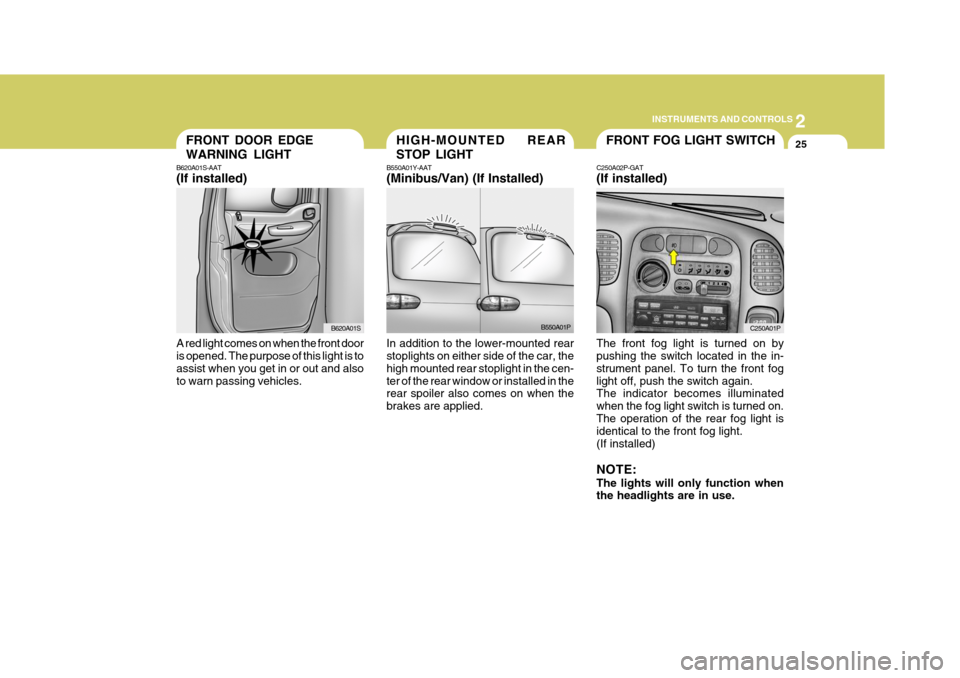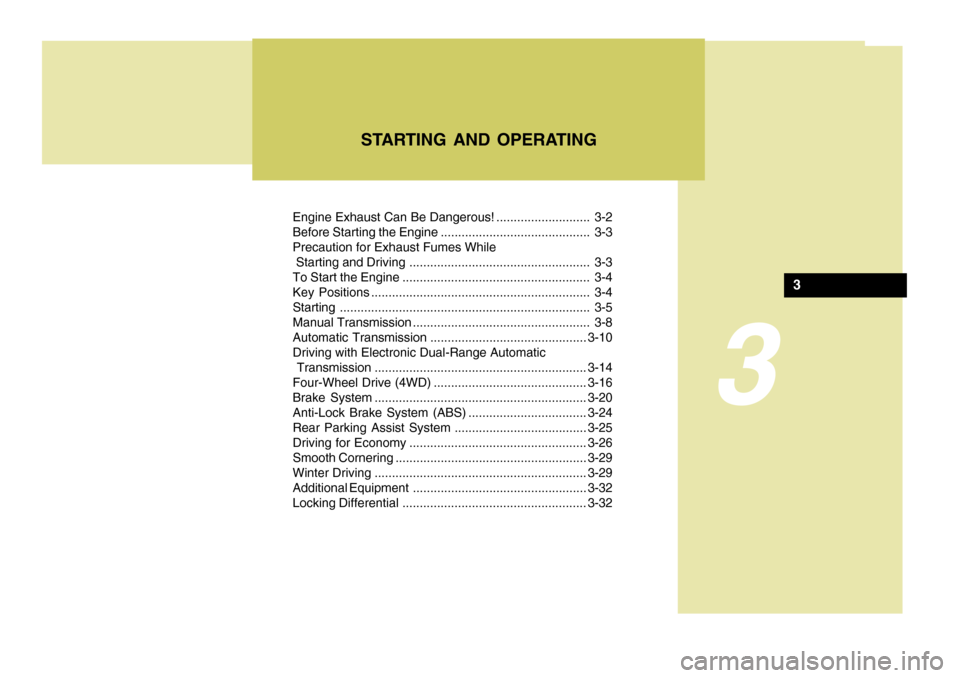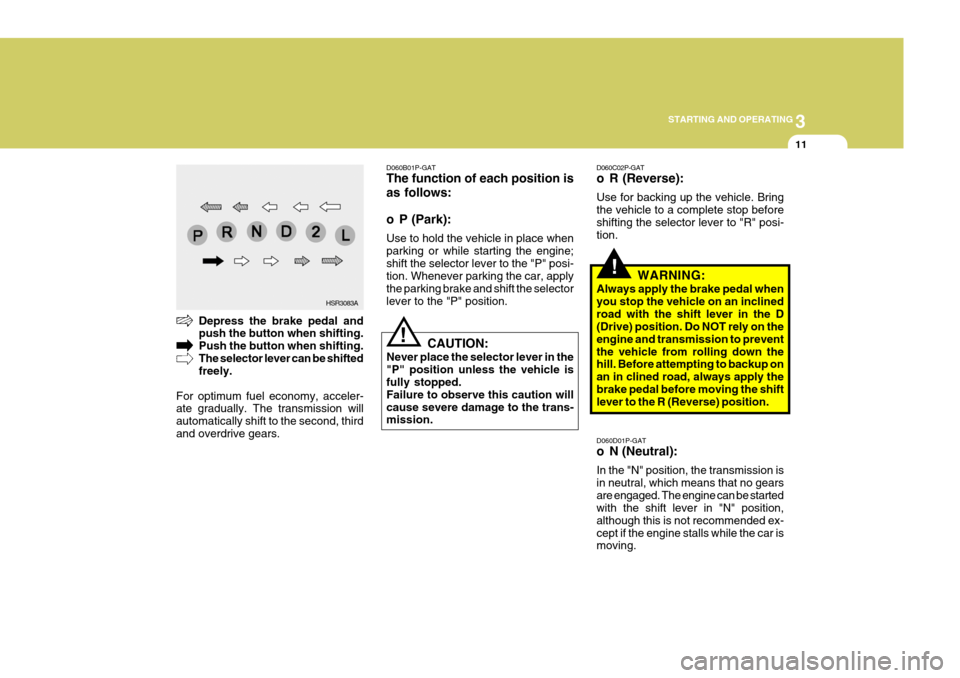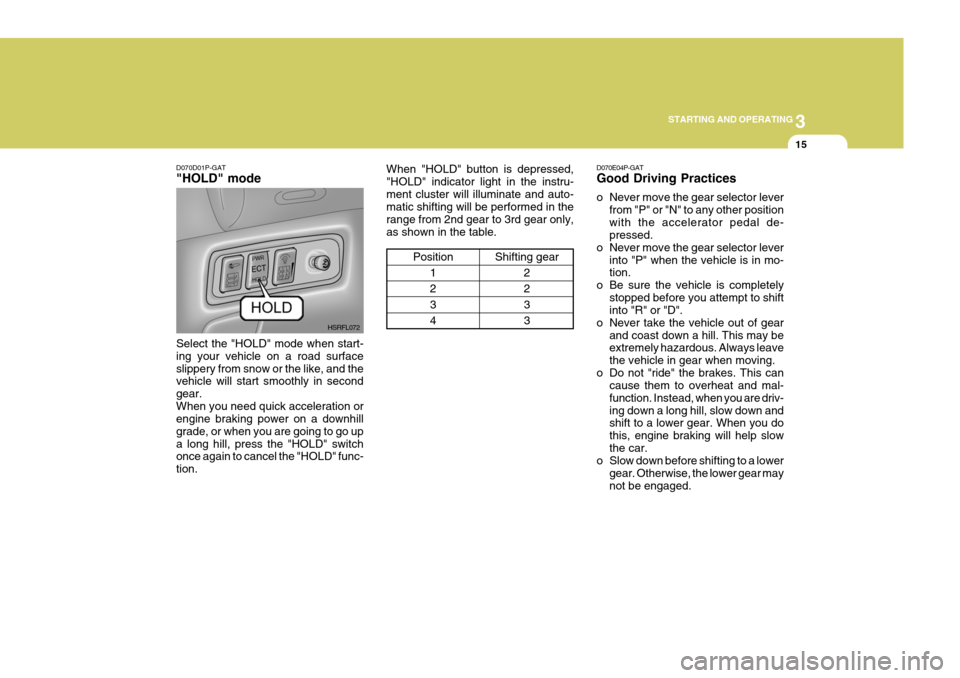2007 Hyundai H-1 (Grand Starex) brake
[x] Cancel search: brakePage 92 of 284

2
INSTRUMENTS AND CONTROLS
25FRONT FOG LIGHT SWITCH
C250A02P-GAT (If installed) The front fog light is turned on by pushing the switch located in the in- strument panel. To turn the front foglight off, push the switch again. The indicator becomes illuminated when the fog light switch is turned on.The operation of the rear fog light is identical to the front fog light. (If installed) NOTE: The lights will only function when the headlights are in use. C250A01PFRONT DOOR EDGE WARNING LIGHT
B620A01S-AAT (If installed) A red light comes on when the front door is opened. The purpose of this light is to assist when you get in or out and alsoto warn passing vehicles. B620A01SHIGH-MOUNTED REAR STOP LIGHT
B550A01Y-AAT (Minibus/Van) (If Installed) In addition to the lower-mounted rear stoplights on either side of the car, the high mounted rear stoplight in the cen-ter of the rear window or installed in the rear spoiler also comes on when the brakes are applied. B550A01P
Page 143 of 284

3
Engine Exhaust Can Be Dangerous! ........................... 3-2
Before Starting the Engine ........................................... 3-3Precaution for Exhaust Fumes While
Starting and Driving .................................................... 3-3
To Start the Engine ...................................................... 3-4
Key Positions ............................................................... 3-4Starting ........................................................................ 3-5
Manual Transmission ................................................... 3-8Automatic Transmission ............................................. 3-10
Driving with Electronic Dual-Range Automatic
Transmission ............................................................. 3-14
Four-Wheel Drive (4WD) ............................................ 3-16
Brake System ............................................................. 3-20
Anti-Lock Brake System (ABS) .................................. 3-24
Rear Parking Assist System ...................................... 3-25
Driving for Economy ................................................... 3-26
Smooth Cornering ....................................................... 3-29
Winter Driving ............................................................. 3-29
Additional Equipment .................................................. 3-32
Locking Differential ..................................................... 3-32
STARTING AND OPERATING
3
Page 145 of 284

3
STARTING AND OPERATING
3PRECAUTION FOR EX- HAUST FUMES WHILESTARTING AND DRIVING
D010A01P-GAT
1. Do not breathe exhaust fumes con- taining carbons monoxide when starting or driving. Carbon monox- ide is a colorless, odorless gas and can cause unconsciousness ordeath by asphyxiation.
2. Open all the windows fully and get
the back door closed if you smellexhaust fumes inside the vehicle. Have the cause immediately located and corrected.
3. Check the exhaust system, from time to time, for holes or loose con-nections if you hear a change in theexhaust sound, or if something has hit the exhaust system.
4. Do not race the engine in a garage
or enclosed area any longer than ittakes to start the engine and drive the vehicle in or out. The sealedexhaust fume may make a particu- larly dangerous situation.
!
BEFORE STARTING THE ENGINE
C020A02O-GAT Before you start the engine, you should always:
1. Look around the vehicle to be sure
there are no flat tires, puddles of oil, water or other indications of pos- sible trouble.
2. After entering the car, check to be sure the parking brake is engaged.
3. Check that all windows, and lights are clean.
4. Check that the interior and exterior
mirrors are clean and in position.
5. Check your seat, seatback and headrest to be sure they are in theirproper positions.
6. Lock all the doors.
7. Fasten your seat belt and be sure
that all other occupants have fas- tened theirs.
8. Turn off all lights and accessories
that are not needed. WARNING (DIESEL ENGINE):
To ensure that sufficient vacuum exists within the brake system dur- ing cold weather start-up condi-tions, it is necessary to run the engine at idle for several seconds after starting the engine.
9. When you turn the ignition switch to
"ON", check that all appropriatewarning lights are operating andthat you have sufficient fuel.
10.Check the operation of warning
lights and all bulbs when key is inthe "ON" position.
!WARNING:
Always wear appropriate shoes when operating your vehicle. Unsuitable shoes (high heels, ski boots, etc.) may interfere with yourability to use the brake and accelera- tor pedal, and the clutch (if installed).
Page 151 of 284

3
STARTING AND OPERATING
9
C070E03A-GAT RECOMMENDED SHIFT POINTS The shift points as shown above are recommended for optimum fuel economy and performance.
Shift
from-to 1-2 2-3 3-44-5 Recommended
20 km/h (15 mph)40 km/h (25 mph) 55 km/h (35 mph) 75 km/h (45 mph)
NOTE:
o To shift into reverse, rest the le- ver in neutral for at least 3 sec- onds after your car is completelystopped. Then move the lever into the reverse position.
o During cold weather, shifting may be difficult until the transmis-sion lubricant has warmed up. This is normal and not harmful tothe transmission.
o If you've come to a complete stop
and it's hard to shift into 1st or"R", put the shift lever in "N" position and let up on the clutch. Press the clutch pedal back down,and then shift into 1st or "R" gear position.
o Do not use the shift lever as a handrest during driving, as thiscan result in premature wear of the transmission shift forks. CAUTION:
When downshifting from fifth gearto fourth gear, caution should be taken not to inadvertently press the gear lever sideways in such a man-ner that second gear is engaged. Such a drastic downshift may cause the engine speed to increase to thepoint that the tachometer will enter the red-zone. Such over-revving of the engine may possibly cause en-gine damage.
!
D050B01P-GAT Using the Clutch The clutch should be pressed all the way to the floor before shifting, then released slowly. Do not rest your footon the clutch pedal while driving. This can cause unnecessary wear. Do not partially engage the clutch tohold the vehicle on an incline. This causes unnecessary wear. Use the parking brake to hold thevehicle on an incline. Do not operate the clutch pedal rapidly and repeat- edly. C070D02O-AAT Good Driving Practices
o Never take the vehicle out of gear
and coast down a hill. This is ex- tremely hazardous. Always leavethe vehicle in gear.
o Don't "ride" the brakes. This can
cause them to overheat and mal-function. Instead, when you are driv- ing down a long hill, slow down and shift to a lower gear. When you dothis, engine braking will help slow the car.
Page 153 of 284

3
STARTING AND OPERATING
11
D060C02P-GAT
o R (Reverse): Use for backing up the vehicle. Bring the vehicle to a complete stop beforeshifting the selector lever to "R" posi- tion. D060D01P-GAT
o N (Neutral): In the "N" position, the transmission is in neutral, which means that no gearsare engaged. The engine can be started with the shift lever in "N" position, although this is not recommended ex-cept if the engine stalls while the car is moving.
HSR3083A D060B01P-GAT The function of each position is as follows:
o P (Park): Use to hold the vehicle in place when parking or while starting the engine;shift the selector lever to the "P" posi- tion. Whenever parking the car, apply the parking brake and shift the selectorlever to the "P" position.
CAUTION:
Never place the selector lever in the"P" position unless the vehicle is fully stopped. Failure to observe this caution willcause severe damage to the trans- mission.
!
Depress the brake pedal and push the button when shifting. Push the button when shifting.The selector lever can be shifted freely.
For optimum fuel economy, acceler-ate gradually. The transmission will automatically shift to the second, thirdand overdrive gears.
!WARNING:
Always apply the brake pedal when you stop the vehicle on an inclinedroad with the shift lever in the D (Drive) position. Do NOT rely on the engine and transmission to preventthe vehicle from rolling down the hill. Before attempting to backup on an in clined road, always apply thebrake pedal before moving the shift lever to the R (Reverse) position.
Page 154 of 284

3 STARTING AND OPERATING
12
D060G01P-GAT
o L (Low gear): Use for driving up a very steep grade or for engine braking when descendingsteep hills. When downshifting to "L", the transmission will temporarily re- main in second gear until the vehiclehas slowed enough for low gear to engage. Do not exceed 50 km/h (31 mph) in low gear."L" engages 1st gear only. However, shift-up to 2nd is performed when the vehicle exceeds a certain speed, andas the speed increases, shift-up to 3rd gear occurs to prevent over-running the engine.
D060E02P-GAT
o D (Drive): Use for normal driving. Bring the car to a complete stop before shifting theselector to "D" position. The transmis- sion will automatically shift through a four-gear sequence, giving besteconomy and power. Never down-shift manually to "2" position or "L" position when vehicle speed is more than 96km/h (60 mph). D060F01P-GAT
o 2 (Second gear): Use for driving on slippery road, hill climbing or engine braking downhill."2" automatically shifts between 1st and 2nd gears. This means that no shift-up to 3rd gearis performed. However, the shift-up to 3rd gear is done when the vehicle speed exceeds a certain value to pre-vent the engine from over-running. Manually move the selector to "D" returning to normal driving condition. D060H02P-GAT
o P (Park): Use this range to park the vehicle. This range is also used when engine isstarted and warmed up.
o N (Neutral): The engine can be started in this range, but the use of P range is recommended for safer start up. NOTE:
o For smooth and safe operation,
depress the brake pedal when shifting from "N" position or "P"position to a forward or reverse gear.
o The brake pedal fully depressed in order to move the shift leverfrom the "P" position to any of the other positions.
o It is always possible to shift from "R", "N", "D", "2", "L" position to"P" position. The vehicle mustbe fully stopped to avoid trans- mission damage.
Page 155 of 284

3
STARTING AND OPERATING
13
If you need to accelerate rapidly, press the accelerator pedal all the way to thefloor. The transmission will automati- cally shift to a lower gear, depending on the speed. NOTE: Turn the overdrive switch on for good fuel economy and smooth driving. If engine braking is neededin the "D" range or if repeated up- shifting and downshifting between the 3rd and 4th gear is needed whenclimbing a gentle slope, it is recom- mended that the overdrive switch be turned off. Turn the overdriveswitch back on immediately after- ward.
CAUTION:
o Shift into "R", "D" and "P" only when the vehicle has completelystopped.
o Do not accelerate the engine in
the reverse or any of the forwardpositions with the brakes applied.
o Always apply the footbrake when
shifting from "P" or "N" to "R","D", "2" or "L" position.
o Do not use the "P" position in
place of the parking brake. Al-ways set the parking brake, shift the transmission into "P" and turn off the ignition when you leave the vehicle, even momen-tarily. Never leave the vehicle unat- tended while the engine is run-ning.
o Check the automatic transmis-
sion fluid level regularly, and addfluid as necessary. See the maintenance schedule for the proper fluid recommen-dation.
! D080A01P-GAT OVERDRIVE SWITCH (If installed) When the overdrive switch is turned on, the transmission will automatically upshift to the second, third and over- drive gears. When the overdrive switchis turned off, the transmission will not upshift to the overdrive gear at all. For normal driving, the selector levershould be left in the "D" position and the overdrive switch turned on. To move the selector lever, the push but-ton on the selector lever handle may have to be depressed first.D080A01P
Page 157 of 284

3
STARTING AND OPERATING
15
D070E04P-GAT Good Driving Practices
o Never move the gear selector lever
from "P" or "N" to any other position with the accelerator pedal de- pressed.
o Never move the gear selector lever into "P" when the vehicle is in mo-tion.
o Be sure the vehicle is completely stopped before you attempt to shiftinto "R" or "D".
o Never take the vehicle out of gear and coast down a hill. This may beextremely hazardous. Always leave the vehicle in gear when moving.
o Do not "ride" the brakes. This can cause them to overheat and mal-function. Instead, when you are driv-ing down a long hill, slow down and shift to a lower gear. When you do this, engine braking will help slowthe car.
o Slow down before shifting to a lower
gear. Otherwise, the lower gear maynot be engaged.
D070D01P-GAT "HOLD" mode Select the "HOLD" mode when start- ing your vehicle on a road surfaceslippery from snow or the like, and the vehicle will start smoothly in second gear.When you need quick acceleration or engine braking power on a downhill grade, or when you are going to go upa long hill, press the "HOLD" switch once again to cancel the "HOLD" func- tion.
When "HOLD" button is depressed,"HOLD" indicator light in the instru-ment cluster will illuminate and auto- matic shifting will be performed in the range from 2nd gear to 3rd gear only,as shown in the table.
Position1 2 34
Shifting gear 2 2 33
HSRFL072